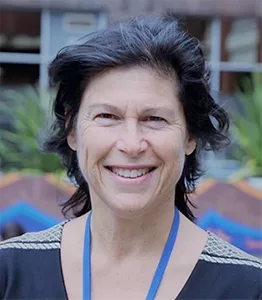Borderline Personality Disorder in Older Adults

Francine Moss, FRANZCP, Older Adult Psychiatrist; Director, St. Vincent’s Older Persons Mental Health Service, Melbourne, Victoria, Australia.
Dr. Moss has no financial relationships with companies related to this material.
CGPR: Can you tell us about the work that you do?
Dr. Moss: I’m a psychiatrist specializing in older adult care at St. Vincent’s Hospital in Australia. We have a comprehensive geriatric program that includes 20 inpatient psychiatric beds and an extensive outpatient/community program where case managers visit patients at home. We also have programs that extend into nursing homes. We have developed a particular interest in borderline personality disorder (BPD) in older people, as this area has been under-researched and under-resourced.
CGPR: Let’s start with diagnosing BPD in older adults. What are some of the main challenges you see?
Dr. Moss: About 30 years ago, personality disorder was viewed as a fixed state and not a treatable illness. We were taught that personality disorders burned out with age, leading to the assumption that they were uncommon, or even irrelevant, in older people. As a result, clinicians rarely screened for personality disorders in this population, and symptoms were often overlooked or misattributed to other causes. Another factor, which may be particular to mental health services in Australia, was that public mental health services focused on treating what they considered “mental illness” rather than personality disorders. When people presented with a personality disorder, they were often turned away because it wasn’t considered treatable. While this view has evolved, that perspective influenced people’s thinking for a long time.
CGPR: What other challenges exist in diagnosis?
Dr. Moss: The diagnosis of personality disorder was always felt to be pejorative, with significant stigma attached (Tyrer P et al, Lancet 2015;385(9969):717–726). Even when clinicians were aware that patients had ongoing interpersonal difficulties alongside other major diagnoses, it often wasn’t labeled due to this stigma and the belief that it could not be treated. This therapeutic nihilism was a setback for many years. The complexity of diagnosis in older people is another major challenge. Patients often have multiple medical diagnoses, several psychiatric diagnoses, and potential underlying cognitive impairment. When we first assess older people, we have to consider all of these factors and determine the primary diagnosis. The presence of neurodegenerative disorders adds a layer of complexity. Geriatric psychiatrists are very reluctant to attribute behavior to personality issues when there is underlying cognitive impairment that may explain the behavior. Additionally, new cognitive changes may increase the challenges for someone with a personality disorder and impact overall functioning.
CGPR: How can clinicians address these diagnostic challenges?
Dr. Moss: The key is to think about BPD in the first place and be aware that it could factor into the presentation. One needs a thorough life history, preferably from someone who’s known the patient well, to understand the issues and difficulties the patient has experienced. It is also important to recognize that personality disorders may present differently in older people—the symptoms can change with age.
CGPR: Sometimes it’s also hard to obtain a collaborative, lifelong history to understand what has troubled a person.
Dr. Moss: Yes, this can be difficult with older adults who may not have living relatives or friends who’ve known them over a lifetime. Sometimes we make the personality disorder diagnosis for the first time in older age, which raises questions since personality disorders are supposedly lifelong. Often, the diagnosis was overlooked entirely, or the person was labeled with other diagnoses instead.
CGPR: How does BPD present differently in older adults?
Dr. Moss: Some features remain prominent while others diminish. There is persistence of emotional dysregulation, intense and unstable interpersonal relationships, poorly controlled anger, and attachment insecurity. We see increased levels of depressivity—lowered mood, dysthymia, emptiness—and more somatic symptoms and complaints. In individuals with BPD, these can include chronic pain, GI distress (stomach aches, irritable bowel symptoms), headaches, and nonspecific fatigue, often without a clear medical cause. These somatic symptoms often become a way of help-seeking. Regarding suicide attempts and deliberate self-harming behavior, the attempts are less frequent but more lethal, and the self-harming behavior may change in form (McMahon K et al, J Psychiatr Res 2019;110:16–23). However, we see lower levels of impulsivity and identity disturbance in older adults with BPD. Interestingly, discussing concepts like identity disturbance or a sense of emptiness with this population can be problematic. This may be due to a cohort effect, as older generations are often less used to discussing complex feelings and emotional experiences. Instead, these feelings might manifest as regrets about life choices, particularly around aspects such as career and parenting roles.
CGPR: Can you speak more about how self-harm presents differently?
Dr. Moss: We see various forms, including misuse of medication, sabotage of treatment (such as refusing rehabilitation or interfering with surgical wounds), disordered eating, and ignoring prescribed diets. While self-harm is less frequently observed in older people, it can still be serious and life-threatening.
CGPR: How common is BPD among older psychiatric patients?
Dr. Moss: The figures vary incredibly widely in the literature, and sometimes the numbers come from adult populations with few older people. One Australian study found levels as high as 60% of psychiatric inpatients aged 65 years and older (Stevenson J et al, Int J Geriatr Psychiatry 2011;26(9):981–987). It really depends on how you’re making the diagnosis, what rating scales you’re using, and whether those scales are even valid for older people.
CGPR: Are there particular screening tools you recommend?
Dr. Moss: While several screening tools exist for personality disorders in older people, none have been specifically validated for older people with BPD. Because of this gap, we developed a rating scale called the BPD-OA (Broadbear JH et al, Clin Gerontol 2022;1–11). Although the scale is not yet validated in a larger sample, a multisite study is currently underway. We focused on the features we know are present in older people and developed questions around those features, including both patient and carer questions. While it’s not currently in widespread use (we’re still working on validating it across a larger sample) the questions proved incredibly helpful in identifying cases. Interestingly, the most predictive questions were those asked of staff caring for the patient, such as “Is this patient often angry or hostile in interactions with staff or family?” Questions asked of patients included “Do you have a lot of sudden mood changes?” and “Have you felt depressed for most of your life?” When considering BPD in older adults, a few targeted questions such as “Have you often felt empty or emotionally unstable?” or “Do you frequently have intense conflict with others?” can serve as helpful starting points for clinicians.
CGPR: What clinical features might suggest BPD when evaluating hospitalized older adults?
Dr. Moss: In an inpatient setting, even when patients don’t have the diagnosis, the nursing staff often quickly identify potential BPD based on ward behaviors—splitting, excessive help-seeking followed by pushing away help, difficulties in relationships with other patients and families, and estrangement from family members. Somatic preoccupation is common across age groups, but in older patients it may present with more dramatic demands for medical attention. There are many clues when you meet a person, but it sometimes takes a few days or weeks to see these behaviors play out.
CGPR: How do you approach treatment once you’ve identified BPD in an older adult?
Dr. Moss: The therapeutic approaches that work in younger people should work in older adults, but identifying the issue helps reframe the situation for staff and other caregivers. General principles, like establishing a therapeutic alliance and providing consistent support and care, work well (Kramer U, Am J Psychother 2025;78(1):11–15). While structured treatments like schema therapy—an approach that targets deeply rooted patterns formed in early life—and dialectical behavior therapy have long been used in younger adults, research on their effectiveness in older people is now emerging (Videler AC et al, Behav Cogn Psychother 2020;48(4):481–491; Lynch TR et al, Int J Geriatr Psychiatry 2007;22(2):131–143).
“One of the most important aspects of BPD treatment is rationalizing medications to eliminate unnecessary ones. People often end up on high doses of antipsychotics without good reason.”
Francine Moss, FRANZCP
CGPR: What about medication management?
Dr. Moss: While we should treat concurrent diagnoses like depression and anxiety, there’s no ideal or single drug that treats BPD itself (Gartlehner G et al, CNS Drugs 2021;35(10):1053–1067). Interestingly, among our cohort, people with BPD often come to us on vast amounts of medication. If someone is on every class of medication in high doses, it might suggest BPD because people have been trying to treat various symptoms. One of the most important aspects of BPD treatment is rationalizing medications to eliminate unnecessary ones (Madan A et al, Prim Care Companion CNS Disord 2015;17(4):10.4088/PCC.14m01760). People often end up on high doses of antipsychotics without good reason. Benzodiazepine (BZD) prescriptions are common, with potential for addiction and misuse. Opioids are also frequently prescribed due to somatic complaints and pain. The focus should be on determining what medications will actually help the person while reducing those that aren’t necessary or have potential for dependence and abuse.
CGPR: What’s your approach to hospitalization for older adults with BPD?
Dr. Moss: We admit primarily to keep the person safe, but with older people, admissions can be prolonged because there are usually multiple issues to address. A person might be admitted due to a crisis, but we often need to manage untreated medical problems, rationalize multiple medications, address situations where they’re seeing multiple clinicians all prescribing BZDs, or handle potential homelessness due to challenging behaviors in their living environment. While some patients with good support systems can have shorter admissions, we often find longer admissions necessary to address these various issues comprehensively.
CGPR: What role do community supports and resources play?
Dr. Moss: In Australia, particularly in Victoria, we have well-developed community teams. Many of our complex patients receive long-term case management from our case managers. We also refer to psychologists outside our service, particularly those with an interest in this population. While these services are helpful, they fall short of best care. Engagement can be a challenge for community-dwelling patients. We’re certainly not able to provide intensive and long-term therapy due to a lack of resources.
CGPR: What is the long-term prognosis for older adults with BPD?
Dr. Moss: BPD tends to be a waxing and waning condition (Videler AC et al, Curr Psychiatry Rep 2019;21(7):51). People might have a very disruptive early adulthood, then find something containing and function relatively well until another significant life event occurs—perhaps the death of a spouse or estrangement from a child. This may precipitate an episode of care with older adult mental health services. This pattern suggests the prognosis can be quite good because we are often seeing people in crisis, whether it’s due to the death of a significant family member, estrangement, or a new medical problem that has changed the person’s independence level. Particularly challenging times often involve transitions to residential care, where we become involved in educating staff and helping to manage the situation. Once these hurdles are overcome, there is hope that the person can have periods that are more comfortable or easier, with some remission of symptoms. However, this isn’t universal; some people have suffered their entire lives, with destroyed relationships, persistent dysthymia and emptiness, and chronic suicidal ideation (Hennings JM, Front Psychiatry 2020;11:199).
CGPR: What can improve outcomes in these cases?
Dr. Moss: I believe specialized intensive therapies (like schema therapy) should be available for this age group. However, this requires specialized services and funding. We have been lobbying for our personality disorder service to expand their funding to include older people. Promising research from the Netherlands has been emerging, as extensive work is being done in this area (Videler AC et al, Aging Ment Health 2018;22(6):738–747). The key is to keep thinking about BPD as a possibility in older adults and to advocate for more specialized services and research in this population. When we do identify BPD, education becomes crucial for both caregivers and clinicians. Families are often relieved to have a diagnosis that explains their loved one’s long-term struggles, and this understanding can help improve care and support strategies.
CGPR: Thank you for your time, Dr. Moss.
Newsletters
Please see our Terms and Conditions, Privacy Policy, Subscription Agreement, Use of Cookies, and Hardware/Software Requirements to view our website.
© 2025 Carlat Publishing, LLC and Affiliates, All Rights Reserved.


_-The-Breakthrough-Antipsychotic-That-Could-Change-Everything.webp?t=1729528747)



